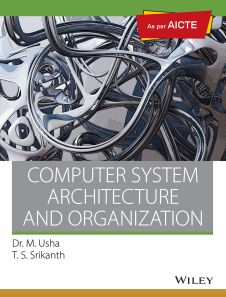Computer System Architecture and Organization, As per AICTE
ISBN: 9788126509836
296 pages
Publication Year: 2019
For more information write to us at: acadmktg@wiley.com

Description
Computer System Architecture and Organization has a good mix of hardware- and software-oriented topics. A comprehensive and up-to-date view of the architecture and internal organization of computers has been presented in the book. The processor design has been dealt with in an in-depth manner. Assuming the readers are familiar with assembly language and digital logic design, the CPU design is explained. For readers who do not have the prerequisite knowledge in Digital Logic design, an Appendix is supplemented at the end.
Chapter 1 Introduction and Trends on Computer Architecture
1.1 Introduction
1.2 Evolution of Computers
1.3 Computer Generations
1.4 Functional Elements of a Computer
1.5 Technology Advancements in Computer Architecture
1.6 Computer Classifications
Chapter 2 Operational Units of a Computer
2.1 Introduction
2.2 Evolution of Bus in Computers
2.3 Internal Bus Architecture
2.4 External Bus Structure
Chapter 3 Data Representations and Arithmetic Algorithms
3.1 Introduction
3.2 Number Representations
3.3 Integer Data Computations
3.4 Multiplication
3.5 Division of Integers
3.6 Floating-Point Data Computations
Chapter 4 Central Processing Unit
4.1 Introduction
4.2 Organization of Central Processing Unit
4.3 ISA Categories
4.4 Basic Concepts of Instructions
4.5 Types of Instructions
4.6 ISA Design
4.7 Addressing Modes
4.8 Control Unit Design
Chapter 5 Memory Organization
5.1 Introduction
5.2 Semiconductor Memory Cell
5.3 Read-Only Memory
5.4 Memory Hierarchies
5.5 Cache Memory
5.6 Virtual Memory
5.7 Secondary Memories
Chapter 6 I/O Organization
6.1 Introduction
6.2 Interfacing I/O Devices
6.3 Program-Controlled I/O
6.4 Interrupts
6.5 Direct Memory Access
6.6 I/O Processors
6.7 I/O Buses
6.8 Bus Standards
Chapter 7 Instruction-Level Parallelism
7.1 Introduction
7.2 Pipeline Hazards
7.3 Designing Instruction Sets for Pipelining
7.4 Superscalar Machines
7.5 Pipeline Performance
Chapter 8 Multiprocessor Systems
8.1 Introduction
8.2 Parallel Processing
8.3 Array Processors
8.4 Structure of a Multiprocessor System
8.5 Interconnection Structures
8.6 Cache Coherence
Chapter 9 Performance Measures for Computer Architecture
9.1 Performance Attributes
9.2 Memory Attributes
9.3 Device Throughput
9.4 Discussions on Selection Schema
Chapter 10 Case Studies
10.1 General-Purpose Processors
10.2 Embedded Applications
Summary
Key Terms
Multiple-Choice Questions
Review Questions
Further Readings
Answers
Appendix: Digital Logic Circuits
A.1 Introduction
A.2 Basic Logic Gates
A.3 Boolean Laws
A.4 NAND Gate Equivalents
A.5 Flip-Flops
A.6 Registers
A.7 Counter
A.8 Multiplexer
A.9 Demultiplexer
A.10 Decoder
A.11 Encoder
A.12 Finite State Machine
Further Readings
Index

